A Method of Damage Detection Efficiency Enhancement of PZT Sensor Networks under Influence of Environmental and Operational Conditions
Abstract
1. Introduction
2. Definition of Damage Indices Compensation Methods
- the so-called standard approach, based on proposition presented in [40], for which where is median of the set of k smallest damage index values obtained for the entire PZT network;
- the symmetric approach for which is estimated symmetrically by drifts contributions corresponding to generator g and s by the term ;
- the minmax approach for which .
3. Experiment Results and Discussion
3.1. Experimental Setup
3.2. Results and Discussion
- denotes the mean value of a given damage index obtained for sensing paths running in the proximity of introduced flaw, which can be sensitive to the transmission mode of guided waves interaction with damage;
- denotes the mean value of a given damage index obtained for sensing paths running at a significant distance from the introduced damage and thus should be less sensitive to its presence.
- to contributed the following sensing paths: 2–3, 2–7, 3–6, 6–7, 1–3, 1–7, 5–7, 3–5, 2–4, 2–8, 4–6, 6–8;
- to contributed the following sensing paths: 1–5, 1–6, 1–2, 2–5, 2–6, 5–6, 3–4, 3–7, 3–8, 4–7, 4–8, 7–8.
- to contributed the following sensing paths: 2–8, 2–5, 4–6, 3–5, 1–7, 1–6, 1–8, 2–6, 2–7, 3–8, 3–6, 4–5, 4–7, 4–8;
- to contributed the following sensing paths: 1–2, 1–3, 1–4, 2–3, 2–4, 3–4, 5–6, 5–7, 5–8, 6–7, 6–8, 7–8.
4. Summary
Author Contributions
Funding
Institutional Review Board Statement
Informed Consent Statement
Data Availability Statement
Conflicts of Interest
Abbreviations
| BVID | Barely Visible Impact Damage |
| DI (DIs) | damage index (damage indices) |
| EOC (EOCs) | environmental and operational condition (conditions) |
| GFRP | Glass Fiber Reinforced Polymer |
| SHM | structural health monitoring |
References
- Fraden, J. Handbook of Modern Sensors; Springer: Berlin/Heidelberg, Germany, 2010; Volume 3. [Google Scholar]
- Boller, C.; Chang, F.K.; Fujino, Y. (Eds.) Encyclopedia of Structural Health Monitoring; John Wiley & Sons, Ltd.: Hoboken, NJ, USA, 2009. [Google Scholar]
- Staszewski, W.; Boller, C.; Tomlinson, G. Health Monitoring of Aerospace Structures; Wiley: New York, NY, USA, 2004. [Google Scholar]
- Mukhopadhyay, S.C. New Developments in Sensing Technology for Structural Health Monitoring; Springer: Berlin/Heidelberg, Germany, 2011; Volume 96. [Google Scholar]
- Adams, D. Health Monitoring of Structural Materials and Components: Methods with Applications; John Wiley & Sons: Hoboken, NJ, USA, 2007. [Google Scholar]
- Bai, C.; Dallasega, P.; Orzes, G.; Sarkis, J. Industry 4.0 technologies assessment: A sustainability perspective. Int. J. Prod. Econ. 2020, 229, 107776. [Google Scholar] [CrossRef]
- Giurgiutiu, V. Structural Health Monitoring: With Piezoelectric Wafer Active Sensors, 2nd ed.; Academic Press: Cambridge, MA, USA, 2014. [Google Scholar]
- Su, Z.; Ye, L. Identification of Damage Using Lamb Waves: From Fundamentals to Applications; Springer Science & Business Media: Berlin/Heidelberg, Germany, 2009; Volume 48. [Google Scholar]
- Heywang, W.; Lubitz, K.; Wersing, W. Piezoelectricity: Evolution and Future of a Technology; Springer Science & Business Media: Berlin/Heidelberg, Germany, 2008; Volume 114. [Google Scholar]
- Stepinski, T.; Uhl, T.; Staszewski, W. Advanced Structural Damage Detection: From Theory to Engineering Applications; John Wiley & Sons: Hoboken, NJ, USA, 2013. [Google Scholar]
- Janapati, V.; Kopsaftopoulos, F.; Li, F.; Lee, S.J.; Chang, F.K. Damage detection sensitivity characterization of acousto-ultrasound-based structural health monitoring techniques. Struct. Health Monit. 2016, 15, 143–161. [Google Scholar] [CrossRef]
- Yadav, S.K.; Mishra, S.; Kopsaftopoulos, F.; Chang, F.K. Reliability of crack quantification via acousto-ultrasound active-sensing structural health monitoring using surface-mounted PZT actuators/sensors. Struct. Health Monit. 2021, 20, 219–239. [Google Scholar] [CrossRef]
- Amerini, F.; Meo, M. Structural health monitoring of bolted joints using linear and nonlinear acoustic/ultrasound methods. Struct. Health Monit. 2011, 10, 659–672. [Google Scholar] [CrossRef]
- Rucka, M. Monitoring steel bolted joints during a monotonic tensile test using linear and nonlinear Lamb wave methods: A feasibility study. Metals 2018, 8, 683. [Google Scholar] [CrossRef]
- Mickens, T.; Schulz, M.; Sundaresan, M.; Ghoshal, A.; Naser, A.; Reichmeider, R. Structural health monitoring of an aircraft joint. Mech. Syst. Signal Process. 2003, 17, 285–303. [Google Scholar] [CrossRef]
- Li, W.; Liu, T.; Zou, D.; Wang, J.; Yi, T.H. PZT based smart corrosion coupon using electromechanical impedance. Mech. Syst. Signal Process. 2019, 129, 455–469. [Google Scholar] [CrossRef]
- Dai, W.; Wang, X.; Zhang, M.; Zhang, W.; Wang, R. Corrosion monitoring method of porous aluminum alloy plate hole edges based on piezoelectric sensors. Sensors 2019, 19, 1106. [Google Scholar] [CrossRef]
- Lim, Y.Y.; Kwong, K.Z.; Liew, W.Y.H.; Soh, C.K. Non-destructive concrete strength evaluation using smart piezoelectric transducer—A comparative study. Smart Mater. Struct. 2016, 25, 085021. [Google Scholar] [CrossRef]
- Zhang, C.; Wang, X.; Yan, Q.; Vipulanandan, C.; Song, G. A novel method to monitor soft soil strength development in artificial ground freezing projects based on electromechanical impedance technique: Theoretical modeling and experimental validation. J. Intell. Mater. Syst. Struct. 2020, 31, 1477–1494. [Google Scholar] [CrossRef]
- Mei, H.; Haider, M.F.; Joseph, R.; Migot, A.; Giurgiutiu, V. Recent advances in piezoelectric wafer active sensors for structural health monitoring applications. Sensors 2019, 19, 383. [Google Scholar] [CrossRef] [PubMed]
- Gorgin, R.; Luo, Y.; Wu, Z. Environmental and operational conditions effects on Lamb wave based structural health monitoring systems: A review. Ultrasonics 2020, 105, 106114. [Google Scholar] [CrossRef]
- Michaels, J.E. Detection, localization and characterization of damage in plates with an in situ array of spatially distributed ultrasonic sensors. Smart Mater. Struct. 2008, 17, 035035. [Google Scholar] [CrossRef]
- Croxford, A.J.; Moll, J.; Wilcox, P.D.; Michaels, J.E. Efficient temperature compensation strategies for guided wave structural health monitoring. Ultrasonics 2010, 50, 517–528. [Google Scholar] [CrossRef] [PubMed]
- Qiu, L.; Yuan, S.; Huang, T. Lamb wave temperature compensation method based on adaptive filter ADALINE network. J. Vibroeng. 2013, 15, 1463–1476. [Google Scholar]
- Radecki, R.; Staszewski, W.J.; Uhl, T. Impact of changing temperature on lamb wave propagation for damage detection. In Key Engineering Materials; Trans Tech Publications Ltd.: Bäch, Switzerland, 2014; Volume 588, pp. 140–148. [Google Scholar]
- Salmanpour, M.S.; Sharif Khodaei, Z.; Aliabadi, M.F. Impact damage localisation with piezoelectric sensors under operational and environmental conditions. Sensors 2017, 17, 1178. [Google Scholar] [CrossRef]
- Moll, J.; Kexel, C.; Pötzsch, S.; Rennoch, M.; Herrmann, A.S. Temperature affected guided wave propagation in a composite plate complementing the Open Guided Waves Platform. Sci. Data 2019, 6, 1–9. [Google Scholar] [CrossRef]
- Chen, F.; Wilcox, P.D. The effect of load on guided wave propagation. Ultrasonics 2007, 47, 111–122. [Google Scholar] [CrossRef]
- Michaels, J.; Michaels, T.; Martin, R. Analysis of global ultrasonic sensor data from a full scale wing test. Rev. Quant. Nond. Eval. 2009, 1096, 28. [Google Scholar]
- Michaels, J.E.; Lee, S.J.; Michaels, T.E. Impact of applied loads on guided wave structural health monitoring. In Proceedings of the AIP Conference Proceedings, Antalya, Turkey, 12–15 May 2011; American Institute of Physics: College Park, MD, USA, 2011; Volume 1335, pp. 1515–1522. [Google Scholar]
- Roy, S.; Ladpli, P.; Chang, F.K. Load monitoring and compensation strategies for guided-waves based structural health monitoring using piezoelectric transducers. J. Sound Vib. 2015, 351, 206–220. [Google Scholar] [CrossRef]
- Park, G.; Farrar, C.R.; di Scalea, F.L.; Coccia, S. Performance assessment and validation of piezoelectric active-sensors in structural health monitoring. Smart Mater. Struct. 2006, 15, 1673. [Google Scholar] [CrossRef]
- Qing, X.P.; Chan, H.L.; Beard, S.J.; Ooi, T.K.; Marotta, S.A. Effect of adhesive on the performance of piezoelectric elements used to monitor structural health. Int. J. Adhes. Adhes. 2006, 26, 622–628. [Google Scholar] [CrossRef]
- Tinoco, H.A.; Serpa, A.L. Voltage relations for debonding detection of piezoelectric sensors with segmented electrode. Mech. Syst. Signal Process. 2012, 31, 258–267. [Google Scholar] [CrossRef]
- Lu, Y.; Michaels, J.E. A methodology for structural health monitoring with diffuse ultrasonic waves in the presence of temperature variations. Ultrasonics 2005, 43, 717–731. [Google Scholar] [CrossRef] [PubMed]
- Ambrozinski, L.; Magda, P.; Dragan, K.; Stepinski, T.; Uhl, T. Temperature compensation based on Hilbert transform and instantaneous phase for Lamb waves-based SHM systems of aircraft structures. In Structural Health Monitoring 2013: A Roadmap to Intelligent Structures: Proceedings of the 9th International Workshop on Structural Health Monitoring; Available online: http://www.signal.uu.se/Publications/pdf/c1313.pdf (accessed on 8 December 2022).
- Dworakowski, Z.; Ambrozinski, L.; Stepinski, T. Multi-stage temperature compensation method for Lamb wave measurements. J. Sound Vib. 2016, 382, 328–339. [Google Scholar] [CrossRef]
- Zhao, X.; Gao, H.; Zhang, G.; Ayhan, B.; Yan, F.; Kwan, C.; Rose, J.L. Active health monitoring of an aircraft wing with embedded piezoelectric sensor/actuator network: I. Defect detection, localization and growth monitoring. Smart Mater. Struct. 2007, 16, 1208. [Google Scholar] [CrossRef]
- Dziendzikowski, M.; Dragan, K.; Katunin, A. Localizing impact damage of composite structures with modified RAPID algorithm and non-circular PZT arrays. Arch. Civ. Mech. Eng. 2017, 17, 178–187. [Google Scholar] [CrossRef]
- Dragan, K.; Dziendzikowski, M. A method to compensate non-damage-related influences on Damage Indices used for pitch-catch scheme of piezoelectric transducer based Structural Health Monitoring. Struct. Health Monit. 2016, 15, 423–437. [Google Scholar] [CrossRef]
- Noliac A/S. Available online: http://www.noliac.com/products/actuators/plate-actuators/show/nac2002/ (accessed on 8 December 2022).
- STEMiNC Inc. Available online: https://www.steminc.com/PZT/en/piezo-disc-transducer-450-khz (accessed on 8 December 2022).
- EC Electronics. Available online: http://ec-systems.pl/tl_files/pdf/files/PL/PAQ%2016000D%20-%20Broszura.pdf (accessed on 8 December 2022). (In Polish).

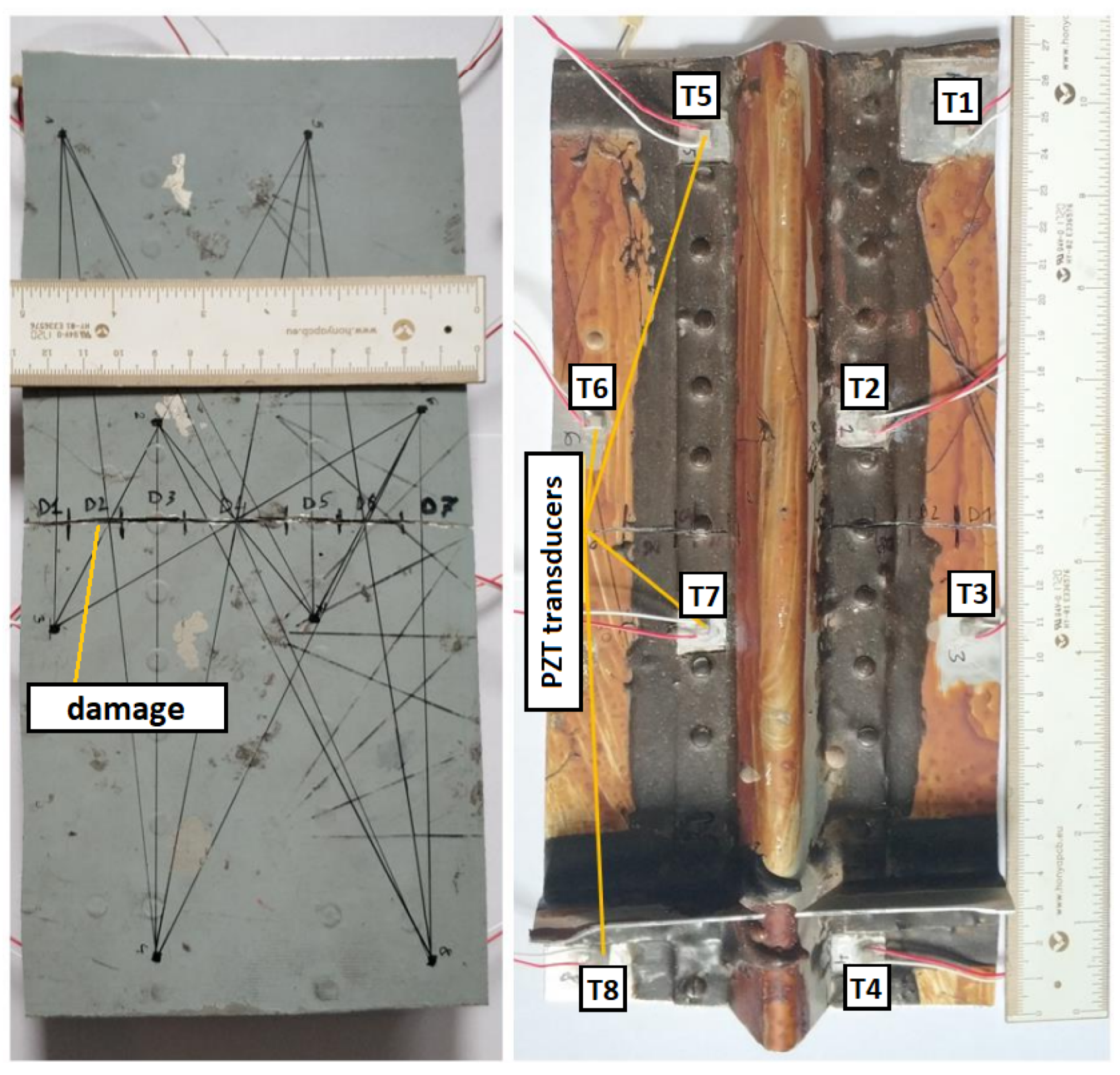
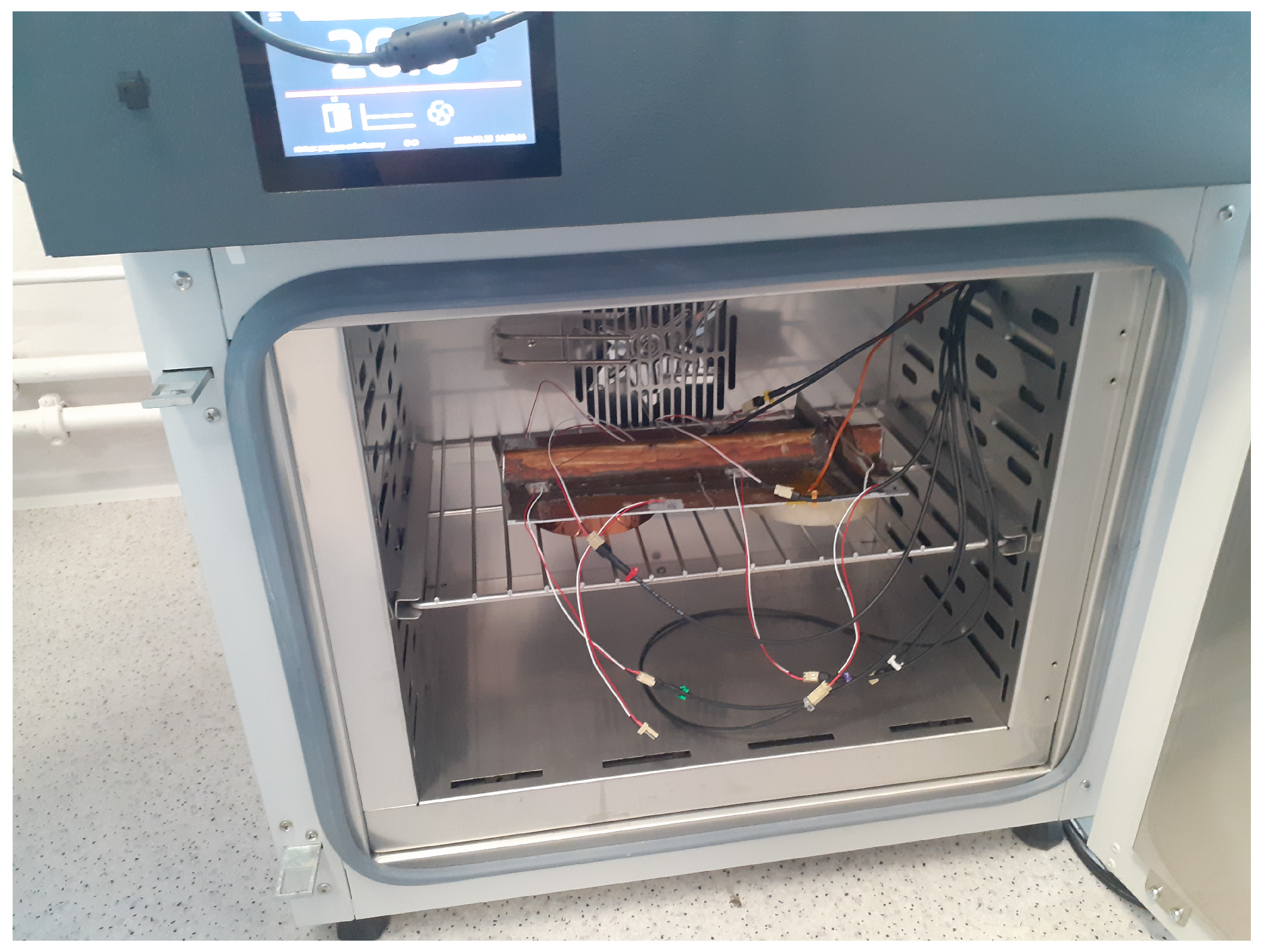

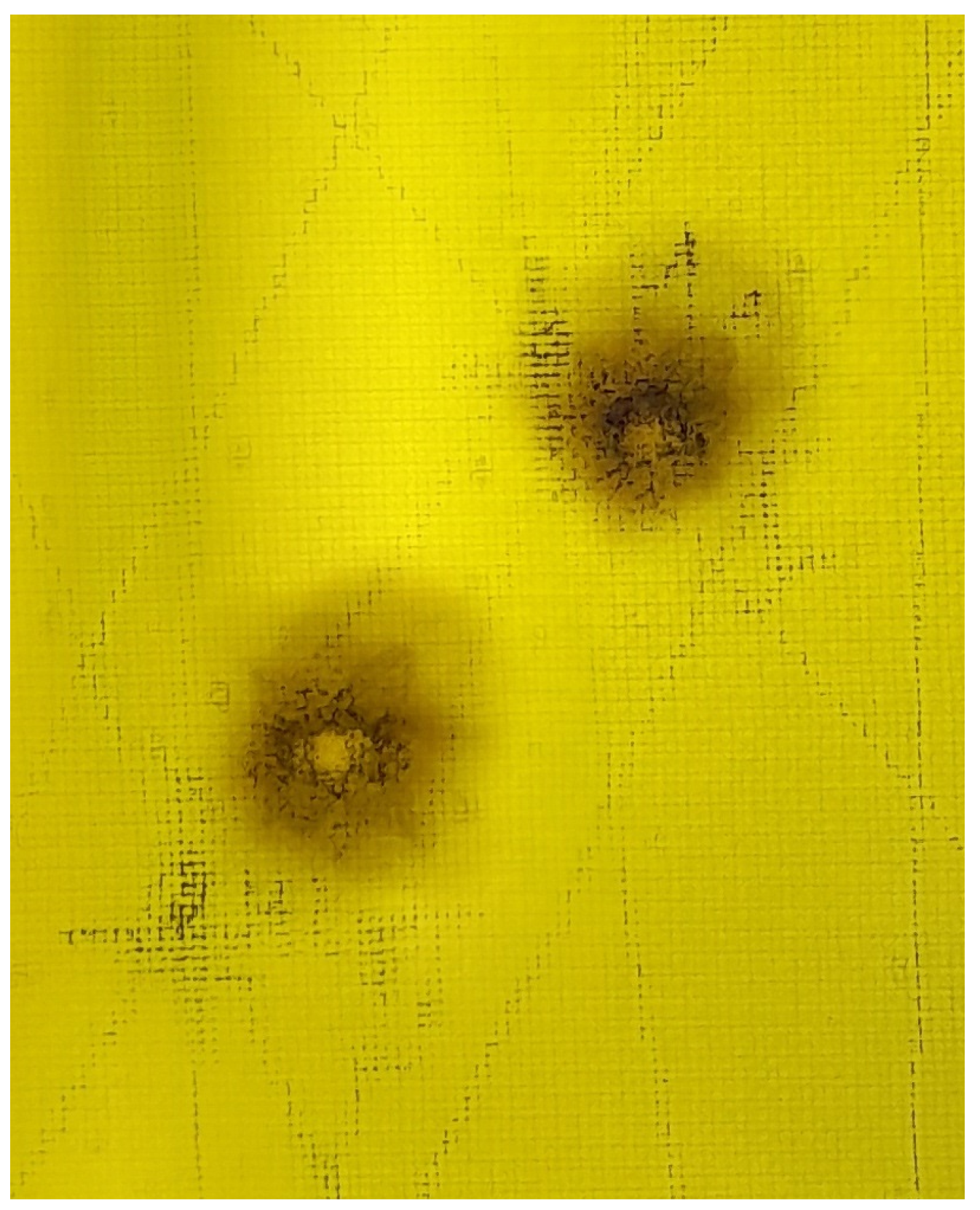
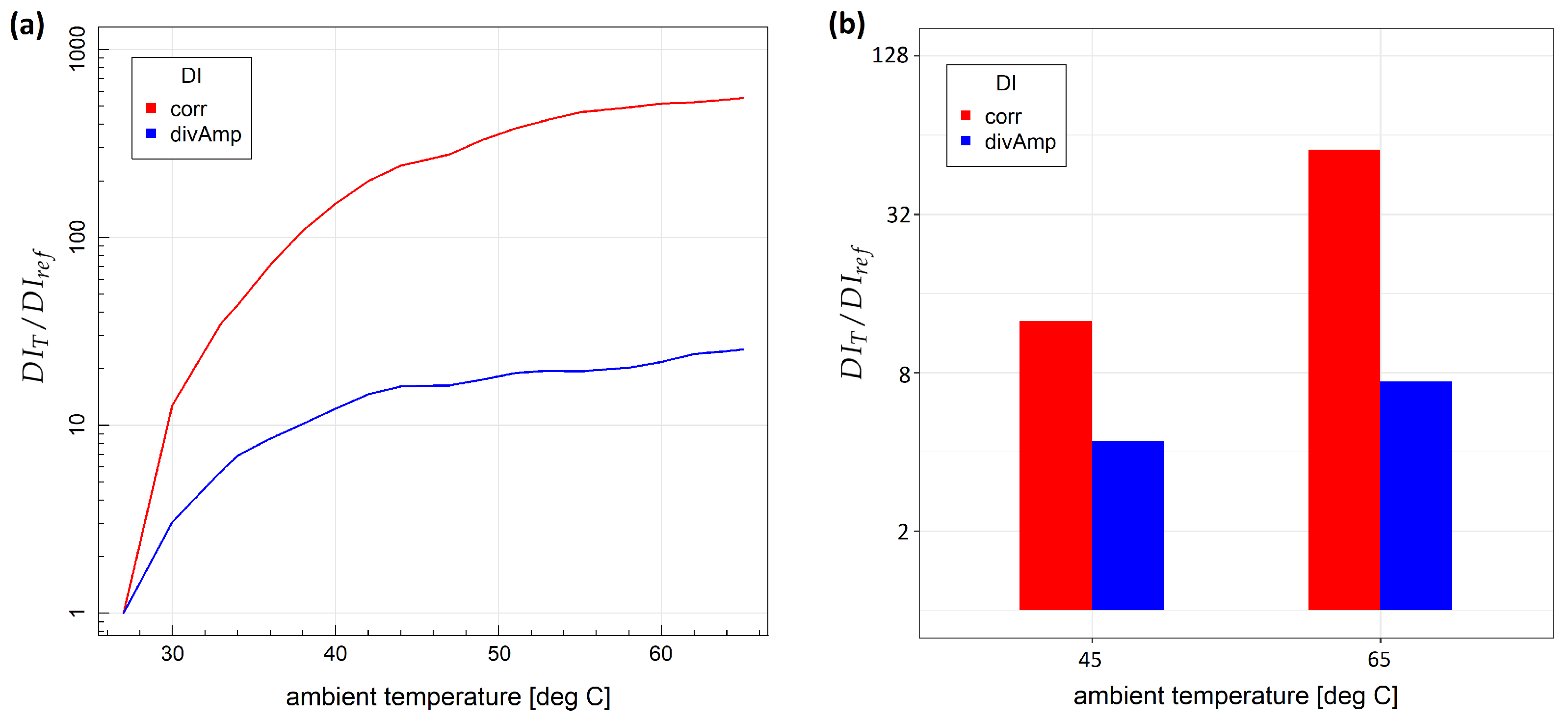
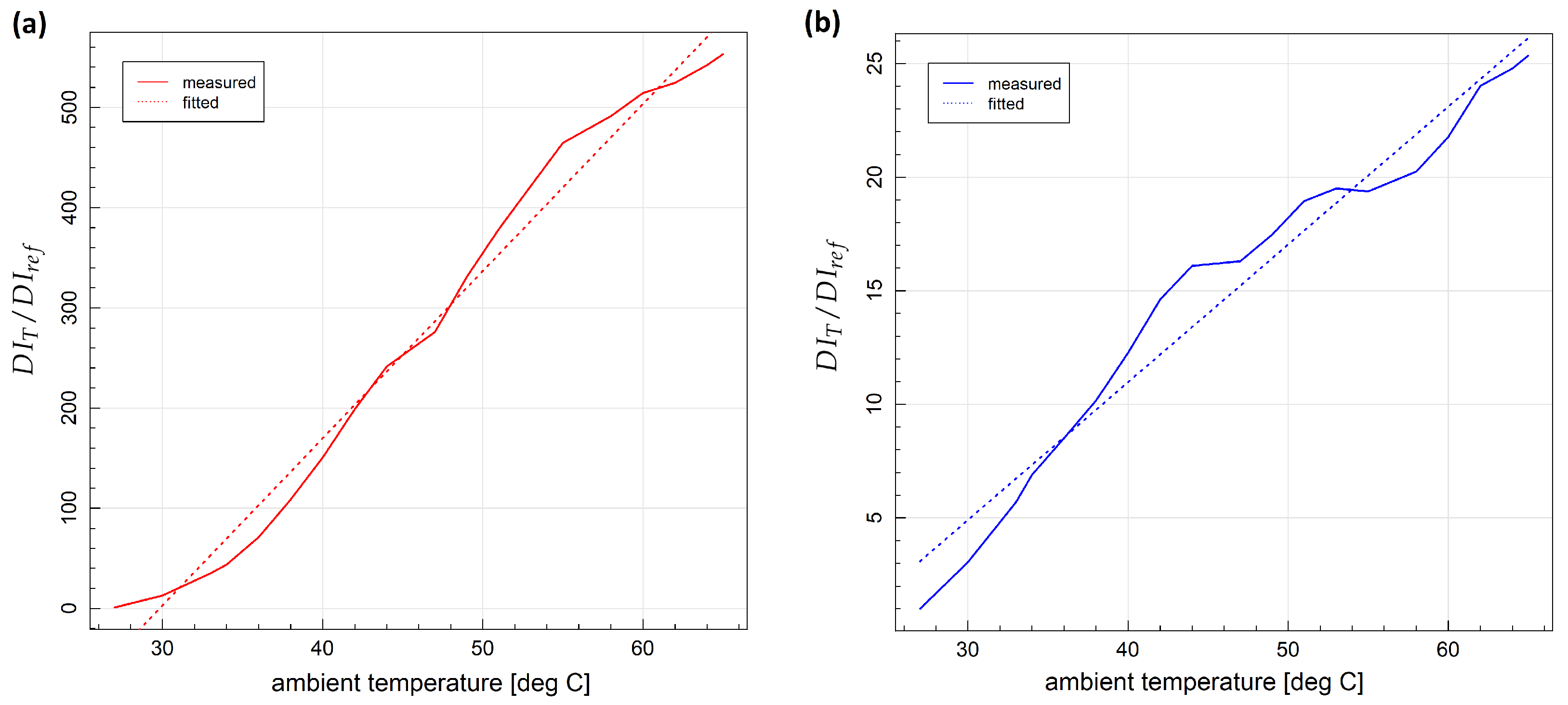





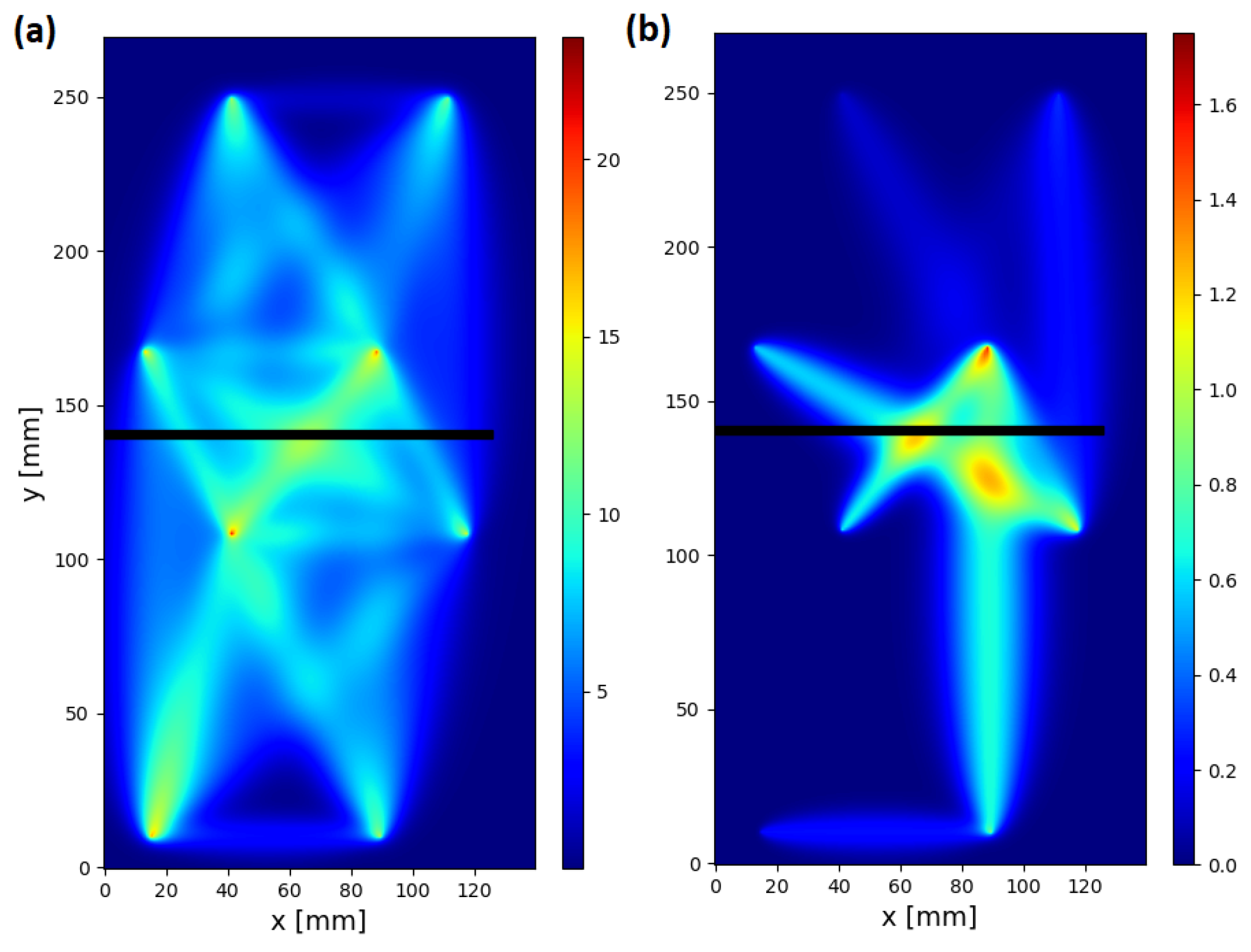
| Temperature Range | ||||
|---|---|---|---|---|
| below 40C | 40C–55C | above 55C | ||
| compensation scheme | standard | 7.11 | 6.37 | 6.76 |
| standard | 9.21 | 8.53 | 10.59 | |
| standard | 19.85 | 17.62 | 10.36 | |
| minmax | 6.62 | 4.97 | 4.84 | |
| minmax | 7.93 | 5.43 | 4.76 | |
| minmax | 12.02 | 8.07 | 5.56 | |
| symmetric | 5.65 | 4.26 | 2.25 | |
| symmetric | 6.95 | 5.31 | 2.65 | |
| symmetric | 9.59 | 7.55 | 3.20 | |
| not compensated | 3.97 | 2.04 | 1.37 | |
| Temperature | |||
|---|---|---|---|
| 45C | 65C | ||
| compensation scheme | standard | 14.91 | 5.99 |
| standard | 19.60 | 7.87 | |
| standard | 139.15 | 33.34 | |
| minmax | 11.84 | 4.28 | |
| minmax | 14.30 | 5.35 | |
| minmax | 23.53 | 14.00 | |
| symmetric | 10.55 | 4.37 | |
| symmetric | 13.20 | 5.37 | |
| symmetric | 22.63 | 7.45 | |
| not compensated | 5.41 | 2.37 | |
| Temperature Range | ||||
|---|---|---|---|---|
| below 40C | 40C–55C | above 55C | ||
| compensation scheme | standard | 11.22 | 8.10 | 7.64 |
| standard | 15.18 | 14.47 | 9.82 | |
| standard | 23.63 | 31.60 | 21.87 | |
| minmax | 11.11 | 7.66 | 7.42 | |
| minmax | 12.99 | 9.59 | 8.61 | |
| minmax | 19.05 | 12.96 | 9.82 | |
| symmetric | 10.40 | 5.85 | 5.39 | |
| symmetric | 12.02 | 7.23 | 6.45 | |
| symmetric | 16.30 | 9.28 | 8.42 | |
| not compensated | 8.31 | 4.21 | 4.04 | |
| Temperature | |||
|---|---|---|---|
| 45C | 65C | ||
| compensation scheme | standard | 3.68 | 0.85 |
| standard | 12.14 | 1.12 | |
| standard | 78.10 | 1.50 | |
| minmax | 2.44 | 0.80 | |
| minmax | 3.06 | 0.81 | |
| minmax | 4.26 | 0.82 | |
| symmetric | 2.20 | 0.79 | |
| symmetric | 2.68 | 0.79 | |
| symmetric | 3.22 | 0.78 | |
| not compensated | 1.75 | 0.86 | |
Disclaimer/Publisher’s Note: The statements, opinions and data contained in all publications are solely those of the individual author(s) and contributor(s) and not of MDPI and/or the editor(s). MDPI and/or the editor(s) disclaim responsibility for any injury to people or property resulting from any ideas, methods, instructions or products referred to in the content. |
© 2022 by the authors. Licensee MDPI, Basel, Switzerland. This article is an open access article distributed under the terms and conditions of the Creative Commons Attribution (CC BY) license (https://creativecommons.org/licenses/by/4.0/).
Share and Cite
Dziendzikowski, M.; Heesch, M.; Gorski, J.; Kowalczyk, K.; Dragan, K.; Dworakowski, Z. A Method of Damage Detection Efficiency Enhancement of PZT Sensor Networks under Influence of Environmental and Operational Conditions. Sensors 2023, 23, 369. https://doi.org/10.3390/s23010369
Dziendzikowski M, Heesch M, Gorski J, Kowalczyk K, Dragan K, Dworakowski Z. A Method of Damage Detection Efficiency Enhancement of PZT Sensor Networks under Influence of Environmental and Operational Conditions. Sensors. 2023; 23(1):369. https://doi.org/10.3390/s23010369
Chicago/Turabian StyleDziendzikowski, Michal, Mateusz Heesch, Jakub Gorski, Kamil Kowalczyk, Krzysztof Dragan, and Ziemowit Dworakowski. 2023. "A Method of Damage Detection Efficiency Enhancement of PZT Sensor Networks under Influence of Environmental and Operational Conditions" Sensors 23, no. 1: 369. https://doi.org/10.3390/s23010369
APA StyleDziendzikowski, M., Heesch, M., Gorski, J., Kowalczyk, K., Dragan, K., & Dworakowski, Z. (2023). A Method of Damage Detection Efficiency Enhancement of PZT Sensor Networks under Influence of Environmental and Operational Conditions. Sensors, 23(1), 369. https://doi.org/10.3390/s23010369









